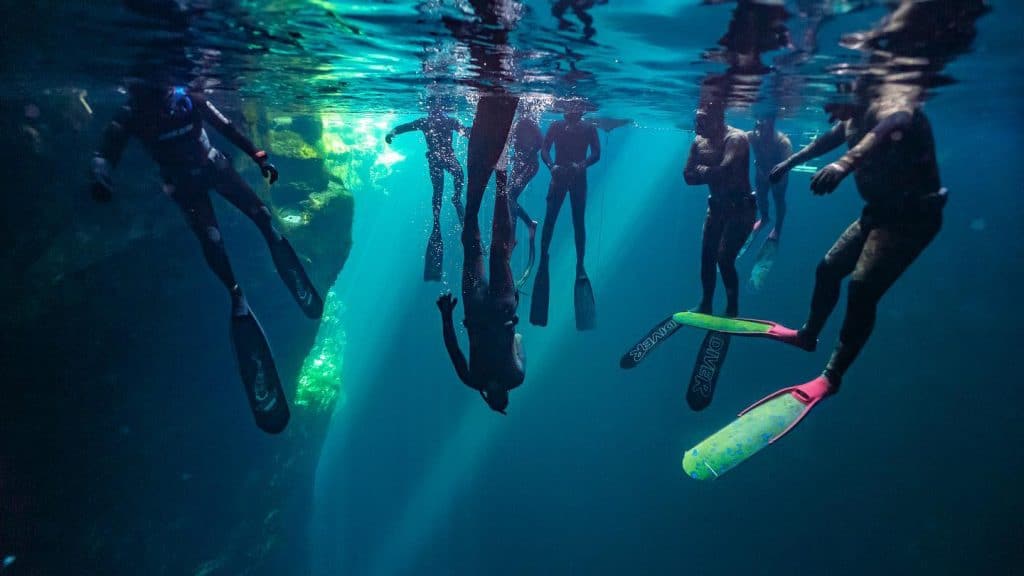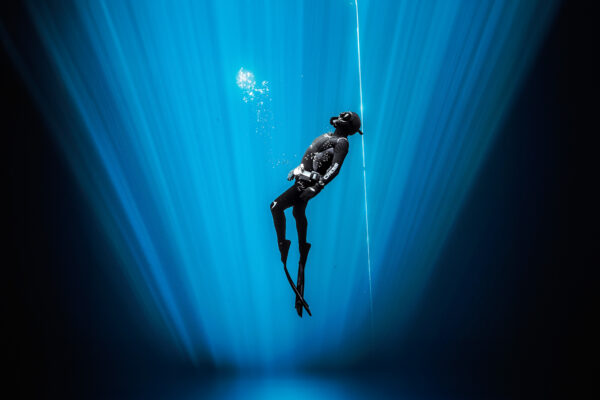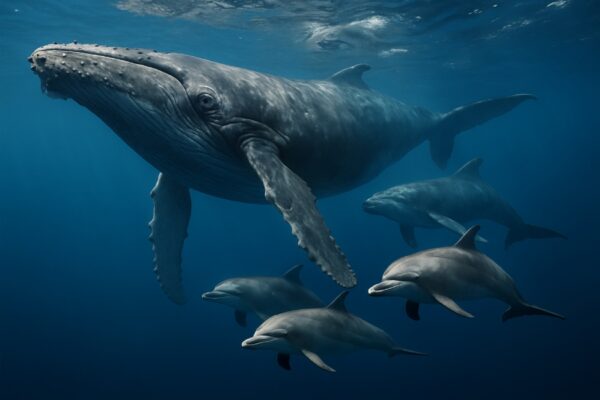The intersection of yoga, pranayama and freedive training.
Gosia Stalinska – Freediving Instructor Student
24th February 2024
In the light of growing awareness and understanding of the freediving discipline, it becomes continually more evident that incorporation of pranayama, stretching and other yoga practices into dive training is highly beneficial and leads to an enhanced performance. This essay explores multidimensional benefits of incorporating yoga, stretching and breath awareness techniques in the context of freediving, highlighting how these practices contribute to physical well-being, mental resilience and improved breath-holding capabilities.
Importance of breath awareness.
Yoga, an ancient spiritual discipline originating in India, encompasses a holistic approach to physical, mental and spiritual well-being. Central to the yoga practice is pranayama, the regulation and control of breath, which serves as a bridge between body and mind.
Breathing techniques help regulate the breath, calm the nervous system, maintain balanced energy levels and enhance the mind-body connection. They facilitate being present in the moment, fostering mindfulness and concentration during asanas (physical postures) and meditation. Conscious breathing in yoga activates the parasympathetic nervous system, promoting relaxation and reducing stress. Deep, controlled breaths can alleviate anxiety before the dive and create a sense of calm.
In freediving, breath awareness is crucial for safety. Proper breath control techniques can help divers manage their oxygen levels, allowing them to stay underwater for extended periods while avoiding hypoxia or hypercapnia. Through specific breath-holding techniques, freedivers can train to improve their ability to hold their breath for longer periods, allowing them to explore greater depths while staying safe within their limits. In freediving, where concentration is essential for safety and performance, having a tool to center the mind is incredibly valuable. Improved focus can aid in decision-making and maintaining awareness of the constantly changing environment underwater.
Breath awareness is fundamental to both yoga and freediving for its role in promoting physical and mental well-being, enhancing focus and ensuring safety. Whether on land or underwater, the practice of conscious breathing contributes significantly to the overall effectiveness and enjoyment of these activities.
There are many breathing techniques which have been recognised for their enhancement to freedive training. One of the most commonly practiced is Diaphragmatic Breathing also known as Dirga Swasam or Three-Part Breath. This technique emphasizes full and deep breathing, engaging the diaphragm. It helps expand lung capacity and allows for efficient exchange of gasses. Diaphragmatic breathing promotes relaxation and can be useful for controlling anxiety or stress before and during a freedive.
Additionally, Ujjayi Pranayama (Victorious Breath) is also often incorporated into pre-dive preparation. Ujjayi involves breathing through the nose with a slight constriction of the throat, creating an audible sound. This technique helps regulate the breath, making it slower and more controlled. It can be beneficial for calming the mind, reducing stress, and promoting concentration, all of which are valuable in freediving.
Bhramari Pranayama (Bee Breath) involves producing a buzzing sound during exhalation. This technique is effective for calming the nervous system and reducing stress. It can be particularly useful for freedivers as a relaxation tool before or after a dive, helping to manage anxiety and tension.
The square breathing technique (Box breathing, Sama Vritti Pranayama) also offers numerous benefits for freedive training, making it a valuable tool for enhancing performance and safety underwater. This method, characterized by equal duration inhalation, breath retention, exhalation and another retention, fosters control over breathing patterns and promotes relaxation. Through regular practice of square breathing, freedivers can train their respiratory system to adapt to prolonged breath holds, thereby extending their diving time and depth potential. Moreover, this technique aids in reducing anxiety and promoting mental clarity, crucial aspects of freediving where maintaining calmness and focus are so important.
Lastly, Nadi Shodhana (Alternate Nostril Breathing with Retention) which involves alternate nostril breathing with breath retention has also been shown for its benefits for freediving training. The controlled breath and brief breath retention periods can enhance lung capacity, improve respiratory efficiency, and promote mental focus, all valuable aspects for freedivers.
The benefits of yoga asana and stretching.
The physical aspect of yoga, asanas (yoga poses) enhance flexibility, strength and body awareness, essential for executing efficient diving techniques and maintaining optimal hydrodynamic positioning underwater.
Stress Reduction and Relaxation.
The meditative aspects of yoga asana foster mental calmness and relaxation, which are highly valuable for freedivers. The ability to remain calm under pressure, regulate breathing, and manage stress is crucial for successful freediving. Yoga practices instill a sense of tranquility that directly translates into the underwater experience. Furthermore, the relaxation induced by effective stretching enhances oxygen utilization, a crucial aspect for extended breath-hold diving.
Body Awareness.
Yoga encourages heightened body awareness through mindfulness and conscious movement. This awareness is beneficial for freedivers in understanding and refining their body positions, allowing for precise adjustments during dives. Improved proprioception contributes to better buoyancy control and streamlined movement beneath the surface.
Posture and correct swimming technique.
By increasing flexibility and range of motion in key muscle groups such as the shoulders, back, and hips, stretching helps to correct imbalances and alignment issues that can negatively impact posture. This improved posture translates directly into the water, as divers can maintain a streamlined body position with reduced drag. Furthermore, stretching encourages the lengthening of tight muscles, which allows for smoother and more efficient movement through the water.
Preventing injuries.
An additional significant benefit of maintaining flexibility and mobility in the chest region is the prevention of injuries such as lung squeeze. Well performed stretching of the intercostal muscles and diaphragm is vital for deep freediving and preventing this and other injuries.
Recovery, rehabilitation and prevention of muscle cramps.
Yoga aids in post-dive recovery by promoting circulation, reducing muscle soreness, and enhancing overall flexibility. Additionally, it can be a valuable tool in rehabilitating injuries or addressing imbalances, ensuring freedivers maintain optimal physical health. The flexibility provided by stretching and yoga is very useful in preventing muscle cramps during both leisure fun diving and line training.
Equalisation.
Stretching plays a pivotal role in facilitating equalization for freediving. By enhancing flexibility, stretching helps to alleviate tension in the muscles surrounding the neck and chest area, which are crucial for equalization maneuvers. In particular, stretching the neck muscles, including the sides of the neck, can significantly improve the diver’s ability to perform equalization techniques effectively. These muscles are interconnected with the muscles utilized in equalizing, thus ensuring that they are supple and unrestricted aids in smoother equalization during descent. Additionally, stretching promotes better blood circulation and relaxation, which further assists in reducing resistance and allowing for more efficient equalization. Overall, incorporating stretching exercises into pre-immersion routines is essential for freedivers to optimize their equalization capabilities and minimize potential challenges during dives.
Target muscle groups.
In freedive training, emphasis on stretching and conditioning various muscle groups is paramount for enhancing flexibility, mobility, and overall performance. Target areas include the diaphragm, thoracic spine, shoulders, chest, abdominals, hips, hamstrings, quadriceps, back, neck, ankles, and feet. Strengthening and stretching these regions not only optimize physical health but also contribute to improved breath-hold duration, efficiency, stability, and fluidity of movement in the water. Thus, integrating yoga and stretching practices into freedive training regimens offers holistic benefits that extend beyond mere physical conditioning, enhancing both performance and well-being in the underwater realm.
In conclusion, the symbiotic relationship between yoga, pranayama and freediving underscores the profound interconnectedness between physical, mental and breath-based practices. By incorporating yoga poses and breath control techniques into their training regimen, freedivers can access many benefits that will enhance their performance, safety and overall well-being in the awe-inspiring depths of the ocean.




